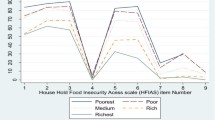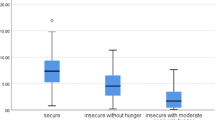Abstract
One-third of India’s urban population resides in extreme poverty, in slums and squatters. Food insecurity remains a visible reality among this segment. Yet, it is scarcely documented. This paper describes levels and determinants of experiential household food insecurity (HFI) in an underserved urban slum of Delhi (India) and reports the internal validity and reliability of the measure used to assess experiential HFI. A four-item scale was adapted from the U.S. six-item short-form food security scale and was administered in Hindi through household interviews with 410 female adults. Association of HFI with household economic and socio-demographic characteristics were examined using multiple logistic regression. Cronbach’s alpha and Rasch-model-based item fit statistics were used to assess reliability and internal validity. Fifty-one percent of households were food insecure. Significant HFI predictors were unemployed to employed family members’ ratio of > 3:1 (Odds Ratio 2.1, Confidence Interval 1.2 – 3.4) and low household standard of living (OR 4.9, C.I. 2.7 – 8.9). Cronbach’s alpha was 0.8. Item severities as estimated under Rasch model assumptions spanned 9.7 logits. Item infit statistics (0.77 – 1.07) indicated that the Rasch model fit the data well. Item outfit statistics suggested that one item was inconsistently understood by a small proportion of respondents. For improving HFI among the urban poor, in addition to improving behaviors/entitlement access, programs should consider linkage of urban poor to existing employment schemes, upgrading of their skills and linkage to potential employers. The adapted scale was reliable and easy to administer. However, being a subjective assessment, its sensitivity to social expectation and its association with nutrition security require examination.
Similar content being viewed by others
Notes
The U.S. Department of Agriculture used these food security category labels in its early food security research (Hamilton et al. 1997). Subsequently, the categories “food insecure with moderate hunger” and “food insecure with severe hunger” were collapsed into a single category “food insecure with hunger.” Beginning in 2006, new category labels were introduced: “low food security” replaced “food insecure without hunger” and “very low food security” replaced “food insecure with hunger”.
References
Adams EJ, Grummer-Strawn L, Chavez G (2003) Food insecurity is associated with increased risk of obesity in California women. Journal of Nutrition 133:1070–1074
Agarwal S, Satyavada A, Patra P, Kumar R (2008) Strengthening functional community—provider linkages: lessons from the Indore urban health programme. Global Public Health 3:308–325
Agarwal S, Srivastava A, Choudhary B, Kaushik S (2007) State of Urban Health in Delhi. Urban Health Resource Center, New Delhi, India [http://uhrc.in/module-ContentExpress-display-ceid-84.html, accessed 6/8/2008]
Agarwal S, Taneja S (2005) All slums are not equal. Indian Pediatrics 42:233–244
Black RE, Allen LH, Bhutta ZA, Caulfield LE, de Onis M, Ezzati M, Mathers C, Rivera J, Maternal and Child Undernutrition Study Group (2008) Maternal and child undernutrition: global and regional exposures and health consequences. Lancet 371:243–260
Blumberg SJ, Bialostosky K, Hamilton WL, Briefel RR (1999) The effectiveness of a short form of the Household Food Security Scale. American Journal of Public Health 89:1231–1234
Carlson SJ, Andrews MS, Bickel GW (1999) Measuring food insecurity and hunger in the United States: development of a national benchmark measure and prevalence estimates. Journal of Nutrition 129:S510–S516
Coates J, Frongillo EA, Rogers BL, Webb P, Wilde PE, Houser R (2006) Commonalities in the experience of household food insecurity across cultures: What are measures missing? Journal of Nutrition 136:S1438S–S1448
Coates J, Webb P, Houser R (2003) Measuring food insecurity: going beyond indicators of income and anthropometry. Food and Nutrition Technical Assistance Project. Academy for Educational Development, Washington DC
Dastgiri S, Tutunchi H, Ostadrahimi A, Mahboob S (2007) Sensitivity and specificity of a short questionnaire for food insecurity surveillance in Iran. Food and Nutrition Bulletin 28(1):55–58
Frongillo EA, Nanama S (2003) Development and validation of an experience based tool to directly measure household food insecurity within and across seasons in northern Burkina Faso. Division of Nutritional Sciences, Cornell University, Ithaca
Biswa. Grain Bank [http://www.biswa.org/activity/socialdev/grainbank.html, accessed 13/8/2008]
Fischer GH, Molenaar IW (eds) (1995) Rasch models: foundations, recent developments, and applications. Springer-Verlag, New York
Gulliford MC, Mahabir D, Nunes C, Rocke B (2005) Self-administration of a food security scale by adolescents; item functioning, socio-economic position and food intakes. Public Health and Nutrition 8(7):853–860
Gulliford MC, Mahabir D, Rocke B (2003) Food insecurity, food choices and body mass index in adults: nutrition transition in Trinidad and Tobago. International Journal of Epidemiology 32:508–516
Gulliford MC, Nunes C, Rocke B (2006) The 18 household food security items provide valid food security classifications for adults and children in the Caribbean. BMC Public Health 6:26
Hamilton WL, Cook JT, Thompson WW, Buron LF, Frongillo EA Jr, Olson CM, Wehler CA (1997) Household Food Security in the United States in 1995: Technical Report of the Food Security Measurement Project. US Dept of Agriculture. Food and Consumer Service, Alexandria
International Institute for Population Sciences and ORC Macro (2006) District Level Household Survey-2, 2002–04. International Institute for Population Sciences, Mumbai
M. S. Swaminathan Foundation (2002) Food insecurity atlas of urban India. M.S. Swaminathan Foundation, Chennai
Ministry of Health and Family Welfare (2000). National Population Policy. Ministry of Health and Family Welfare, Government of India, New Delhi [http//www.populationcommission.nic.in/npp_intro.htm, accessed 2/5/2008]
National Sample Survey Organization (2008). National Sample Survey (62nd round) of poverty estimates for the year 2005–06. NSS report no. 523. Ministry of Statistics and Programme implementation, Government of India, New Delhi.
Nolan M, Williams M, Rikard-Bell G, Mohsin M (2006) Food insecurity in three socially disadvantaged localities in Syndey, Australia. Health Promotion Journal of Australia 17(3):247–254
Nord M, Bickel G (2002) Measuring Children’s Food Security in US Households, 1995–99. Food Assistance and Nutrition Research Report No. 25. Economic Research Service, US Department of Agriculture, Washington, DC.
Nord M, Satpathy AK, Raj N, Webb P, Houser R (2002) Comparing household survey-based measures of food insecurity across countries: case studies in India, Uganda, and Bangalesh. Tufts University Discussion Paper No. 7. [www.http://nutrition.tufts.edu/publications/fpan, accessed 10/10/2008]
Office of the Registrar General and Census Commissioner of India (2006) Population Projections for India and the States 2001-26. Office of the Registrar General and Census Commissioner, New Delhi
Olson CM (1999) Nutrition and health outcomes associated with food insecurity and hunger. Journal of Nutrition 129:S521–S524
Press Information Bureau, Government of India (2007) Public distribution system and other sources of household consumption, 2004–05. New Delhi: Press Information Bureau, Government of India, New Delhi [http://www.mospi.gov.in/press_note_510-Final.htm, accessed 2/8/2008]
Streiner DL, Norman GR (1989) In health measurement scales. A practical guide to their development and use. Oxford University, Oxford
Tingay RS, Tan CJ, Tan NCW, Tang S, Toeh PF, Wong R, Gulliford MC (2003) Food insecurity and low income in an English inner city. Journal of Public Health Medicine 25:156
Townsend MS, Peerson J, Love B, Achterberg C, Murphy SP (2001) Food insecurity is positively related to overweight in women. Journal of Nutrition 131:1738–1745
United Nation's Food and Agriculture Organization (1996). Rome declaration on world food security. World Food Summit, Rome, Italy [http://www.fao.org/docrep/003/w3613e/w3613e00.htm, accessed 6/8/2008]
Urban Health Resource Center (2008) Health of the Urban Poor in India. Key results from the re-analysis of NFHS-3, 2005–06 data by wealth index quartiles (Wall chart). Urban Health Resource Center, New Delhi [http://www.uhrc.in/downloads/wall-chart.pdf, accessed 2/8/2008]
US Department of Agriculture (2008). U.S. Household Food Security Survey Module: Six-Item Short Form. Economic and Research Service, US Department of Agriculture, Washington DC.
Wishik SM, Van der Vynkt S (1976) The use of nutritional `positive deviants' to identify approaches for modification of dietary practices. American Journal of Public Health 66:38–42
Acknowledgements
We are grateful to the respondents and local facilitators for their active participation in this study. We are thankful to Pradeep Patra, Mainak Chatterjee, S. Kaushik, Paramita Banerjee and Dimple Kondal for their support.
Disclaimer
The opinions, findings, and conclusions or recommendations expressed herein are those of the authors and do not necessarily reflect the views of the institutions the authors are affiliated with.
Authorship Statement
SA conceptualized and designed the study and participated in conceptualization of the paper. VS conceptualized the paper and analysis plan, conducted the descriptive data analysis and drafted the manuscript. AA designed the study tools and supervised data collection and data entry. AA also participated in conceptualization of the paper. PG and MJ collected the data, carried out the data entry and participated in data interpretation. MD conducted the Rasch model analysis and wrote related sections of the manuscript. All authors provided inputs in reviewing and editing the manuscript.
Conflict of Interest
None.
Author information
Authors and Affiliations
Corresponding author
Rights and permissions
About this article
Cite this article
Agarwal, S., Sethi, V., Gupta, P. et al. Experiential household food insecurity in an urban underserved slum of North India. Food Sec. 1, 239–250 (2009). https://doi.org/10.1007/s12571-009-0034-y
Received:
Accepted:
Published:
Issue Date:
DOI: https://doi.org/10.1007/s12571-009-0034-y




